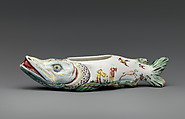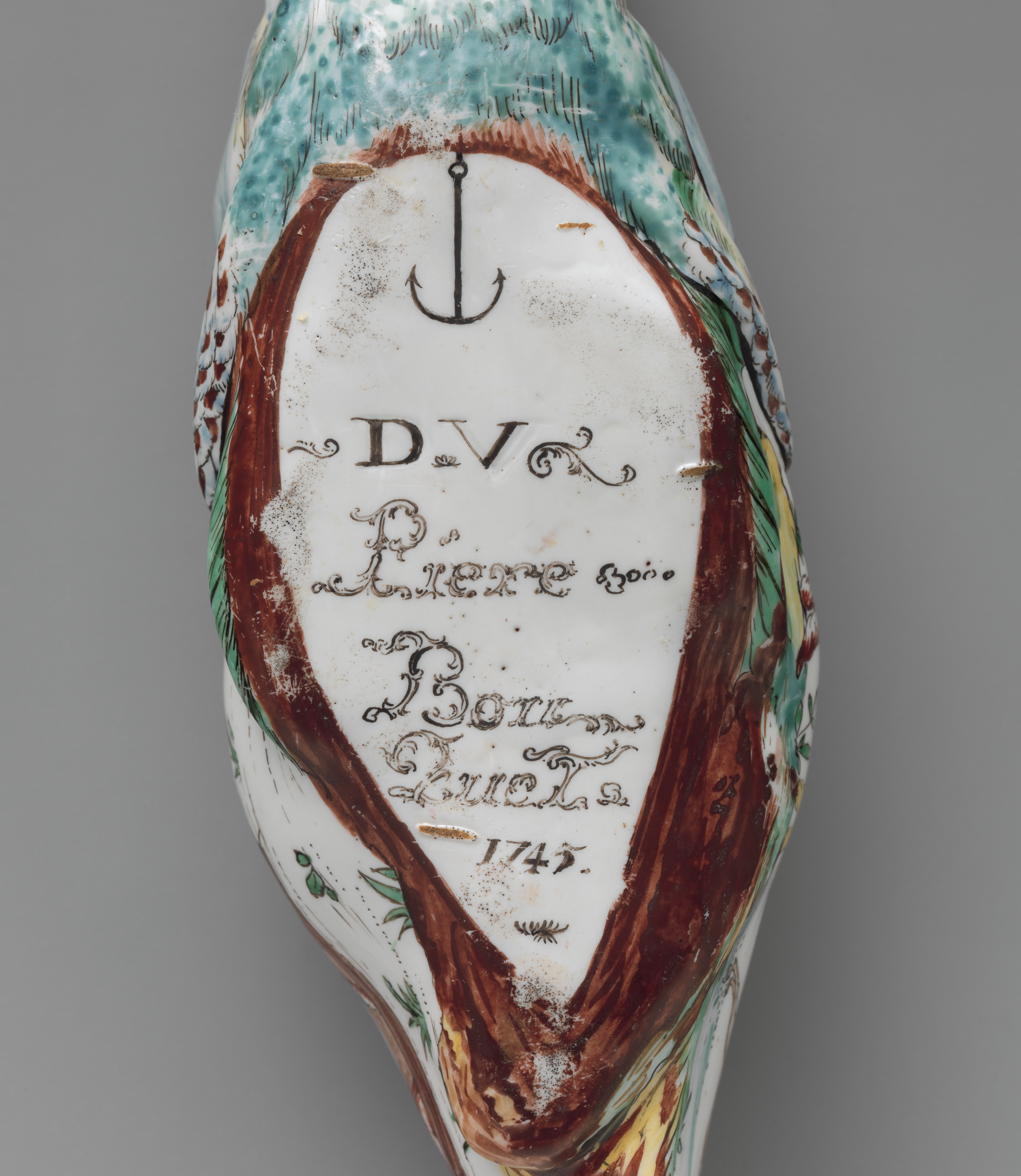Feeding bowl
Factory Villeroy French
This feeding vessel in the form of a fish is a remarkable object from the Villeroy factory. It is one of the most ambitious surviving sculptural works made at the factory,[1] and the vessel is notable for being the only known dated piece of Villeroy porcelain. In addition, this work bears an extensive inscription not found on any other object produced at the factory. However, despite its date and inscription, certain aspects of the vessel remain obscure.
Modeled to depict a pike, or a freshwater fish, the vessel is distinguished by its razorlike teeth that are clearly delineated in the fish’s mouth. An oval opening in the upper section of the fish provides access to the hollow body, which would have probably contained a soup, broth, or some other type of liquid to be poured through the hole formed in the pike’s mouth. The tail of the fish would have allowed the vessel to be tipped in order for the liquid to be consumed. The head, gills, and tail are painted to evoke the corresponding areas of a pike’s body; at the same time, either side of the middle section of the fish is decorated with figures in an aquatic landscape. On one side, a woman is ferried in a boat by a male figure wearing a robe, presumably intended to represent a Chinese man. A large canister is located prominently in the front of the boat. On the other side, two figures wearing similar robes stand near a leaping doglike animal, the identification of which is difficult to determine.
The unusualness of these compositions suggests that the scenes have particular meanings, though their significance remains unclear. The choice of aquatic landscapes is logical given the form of the vessel, but the combination of images suggests a more specific symbolism. The depiction of an anchor on the underside is clearly linked to the vessel’s marine themes, but it is not known if the anchor relates to the name inscribed on the underside, serves as the mark of the vessel’s painter,[2] or has some other as-yet-undiscovered significance.
Even the name underneath and the letters used to spell it are open to interpretation. The name is read by this author as “Piere Bouquet,” with the two syllables of the last name inscribed on different lines, but the last name has been read by others as “Bonzuel,”[3] and as “Bon[?] Ducet.”[4] The understanding of the name is made more challenging by the painter’s use of flourishes to decorate certain letters. A further complexity is provided by the markings near “Piere,” which can be read either as a decorative flourish or as “Bon.”
It has not been possible to trace “Piere” with a last name corresponding to any of the three spellings from the mid-eighteenth century, and thus the identity of the person whose name is inscribed remains a mystery, as does the significance of its appearance on the vessel. If the vessel was intended for feeding an infant, it is probable that the name is for the child who would have used it, suggesting, too, that the vessel was made to commemorate a birth. If the Villeroy fish were made for feeding an invalid,[5] it can be assumed that the inscribed name does not refer to the intended user but rather it must signify someone else. The lack of precedent for a painter at any porcelain factory to sign a work with this degree of prominence and the absence of any record of a worker at Villeroy with this name [6] discount the possibility that the name can be interpreted as that of the person who decorated it.
The letters DV also appear prominently on the underside of the vessel, probably referring to the duc de Villeroy;[7] it is not surprising that his initials would serve as the mark for the factory that had secured his protection.[8] Similar to other markings on the underside, the DV mark is painted in black enamel, and other surviving Villeroy porcelain suggests that the DV mark was painted on most, if not all, of the factory’s production. In addition, the DV mark appears in incised form, which is more commonly found on works produced at Mennecy, the successor factory to Villeroy established in 1750 by François Barbin (French, ca. 1689–1765), two years after the Villeroy operation closed.[9]
The unusual assortment of markings on the underside and the obvious importance attached to them suggest that the Villeroy fish was recognized as one of the factory’s most significant achievements at the time of manufacture. In terms of form and decoration, the fish reflects a degree of sophistication and technical skill that distinguish it from the rest of Villeroy’s production. Dated 1745, this object was made at a time when the factory employed only two workers,[10] which makes the circumstances of its production even more puzzling. While further documentary research may answer some of the questions raised by this intriguing object, no additional information is needed to appreciate the Villeroy fish for the creativity and originality that it embodies.
Footnotes
(For key to shortened references see bibliography in Munger, European Porcelain in the Metropolitan Museum of Art. NY: The Metropolitan Museum of Art, 2018)
1 See also a pair of appliques, or wall pockets, in the Musée des Arts Décoratifs, Paris (36278), which probably can be attributed to Villeroy, despite the incised DV mark more commonly associated with Mennecy. I am grateful to Errol Manners, E & H Manners, London, for bringing these objects to my attention.
2 This interpretation is suggested in Blaise 2001, p. 40.
3 J.- G. Peyre 2000, p. 92; Blaise 2001, p. 40.
4 Dawson 1994, p. 48.
5 The vessel is called a canard de malade (a term that does not allow for literal translation) in J.-G. Peyre 2000, p. 92.
6 See Duchon 1988, pp. 100–118.
7 François-Louis-Anne de Neufville (1695–1766), who became the fourth duc de Villeroy in 1734.
8 The initials DV were also used on boundary markers establishing the border of the duchy of Mennecy, which encompassed Villeroy; J.-G. Peyre 2000, p. 92.
9 This hypothesis was proposed in Le Duc 1987, p. 26. One known exception is offered by a tobacco jar and cover with an incised DV mark that is fitted with silver mounts bearing the discharge mark of Louis Robin (French, active at least 1738–44) for the years 1735–38, which suggests that the jar was made prior to at least 1748, the year the Villeroy factory closed; Gage and Marsh 1988, pp. 102–3, no. 16. I am grateful to Donna Corbin, Associate Curator, Philadelphia Museum of Art, for bringing this to my attention.
10 Le Duc 1987, p. 30.
Due to rights restrictions, this image cannot be enlarged, viewed at full screen, or downloaded.
This artwork is meant to be viewed from right to left. Scroll left to view more.




